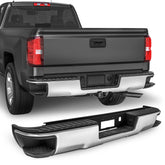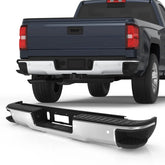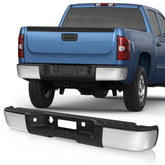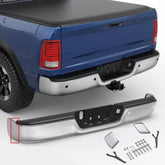How To Remove And Replace The Rear Bumper?
Have you ever been in a collision while backing up? Our expert hit a utility pole while backing up a few days ago. Fortunately, the body and interior components of his car were not damaged due to the bumper installed on the rear of the car, but he had to replace his dented rear bumper. To do this, he replaced his Chevy Silverado with a new MOSTPLUS rear bumper.
In this article, our expert will introduce you to the entire bumper replacement process and provide you with the guidelines you may need. If your bumper happens to be damaged, DIY is a very worthwhile option that can save you from the high cost of replacing the bumper at a car mechanic.

How to replace the rear bumper?
The process is simple, but there are some key steps to follow for a smooth installation. Let’s get started.
Step 1: Locate and remove the bolts
Locate the bolts holding the bumper. There are five bolts on each side of the bumper (driver and passenger side) for a total of ten bolts. However, be aware that if you forget the third bolt on the side of the frame rail, you may run into problems as it is often overlooked. Also, one bolt is next to the light bulb behind the license plate, so don't forget to remove that bolt as well. You will only need the impact wrench here, but if you get into a tight spot, you may need to use a breaker bar to loosen the bolts so that you can finish it off with a regular ratchet.
Step 2: Loosen the truck bed
Once the bolts are removed, you'll need to loosen the truck bed slightly to make room for the bumper to be removed. This step is easy to understand and easy to do. There are four bolts on each side of the truck bed that you should loosen about half an inch. When you're ready to remove the bumper, the bed will lift and you'll be able to unbolt the bumper easily. You can use an impact wrench for this step, but some of the bolts may need to be extended a bit.
Step 3: Lift the truck bed
Now that you have unbolted the bumper and bed, you can easily remove the bumper by just lifting the truck bed a little. To safely lift the truck bed, it is recommended to use a forklift. If you don't have a forklift, find another way to safely lift the bed. If it falls or something goes wrong, you could be seriously injured. Be sure to keep yourself safe while you work. If you can't handle it alone, ask your friends for help.

Step 4: Remove the bumper
Now, lift the bed and carefully pull the bumper towards you. Rock it back and pull it upward to slide it out from under the bed of the truck. The bumper's L-shaped brackets will need to be handled at the correct angle during removal. If your old bumper has trim on it, you can remove it at this time, which can be very time-consuming and tedious.
Step 5: Transfer brackets and Install the new bumper
After removing the old bumper, unscrew the brackets from the old bumper and re-transfer them to the new bumper. These brackets are secured with hex screws. When re-attaching the trim on the new bumper, use a rubber mallet to make sure all the plastic clips are properly secured. Pay attention to your strength and the condition of your plastic clips at this time. If you use too much force and break it, the trim will not be fixed on the new bumper.
Step 6: Reinstall wiring and light brackets
Next, reinstall the trailer brake wiring harness and the license plate light bracket. Make sure everything is securely connected, using a 9mm socket if necessary.
Step 7: Final adjustments and reassembly
Finally, reinstall the bumper by lifting the truck bed again and sliding it back into place, making sure it fits at the correct angle with the L-brackets. Once everything is in place, tighten all the bolts and make sure they are torqued correctly. Reinstall all covers, including the spare tire release cover and the side step covers. After following these steps, your truck will look like new with a securely mounted rear bumper.

Why is the rear bumper important?
When your pickup truck is equipped with a rear bumper, you have an extra layer of protection when driving the vehicle. The rear bumper can reduce the severity of damage to the vehicle after a collision. The biggest function of the rear bumper is to absorb the impact of the collision and prevent or reduce the damage to the rear of the vehicle in low-speed collisions. It can well protect the fuel tank, rear lights, body frame, trunk or rear box, etc. These internal components are often fragile and costly to repair. The presence of the rear bumper can reduce their damage in low-speed collisions. Some of today's rear bumpers are not only a protective component but also enhance the versatility of the vehicle. They will integrate trailer hooks, towing equipment, or foot pedals, providing great convenience for truck owners who often need to tow or transport goods.
Conclusion
Following our replacement guide, replacing the rear bumper will no longer be a difficult task. After the replacement, be sure to drive carefully and safely to avoid collisions, and also prevent other drivers from rear-ending you. After all, a new rear bumper is also a considerable expense. Now you can set off and continue to enjoy your driving pleasure!

FAQs
Is it safe to drive without a rear bumper?
Driving without a rear bumper is unsafe and may also be illegal. The rear bumper is designed to absorb the impact in the event of a collision, and without it, you are vulnerable to injury in a minor accident and the vehicle may not function properly. Additionally, in many areas, driving without a rear bumper may result in a fine or penalty as it may violate road safety laws and vehicle equipment regulations.
What are holes in the rear bumper for?
The holes in the rear bumper are used to install equipment such as parking sensors, tow hooks, or exhaust pipes, and some are used to fix the connection parts between the bumper and the body. In addition, some holes may be used for drainage or air circulation, helping to improve the aerodynamic performance of the vehicle or preventing moisture accumulation. The design of these holes is not only functional but also makes the rear of the vehicle look more beautiful.
How much rear bumper weight?
The weight of your rear bumper can vary greatly depending on the vehicle type, material, and design. For most standard passenger cars, the rear bumper typically weighs 20 to 40 pounds (9 to 18 kg). Larger vehicles, such as trucks or SUVs, can weigh 40 to 60 pounds (18 to 27 kg) or more.
Featured Products
- $299.99
$359.99- $299.99
- Unit price
- / per
- $289.99
$368.99- $289.99
- Unit price
- / per
- $294.99
- $294.99
- Unit price
- / per
- $279.99
- $279.99
- Unit price
- / per














